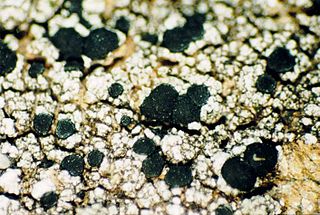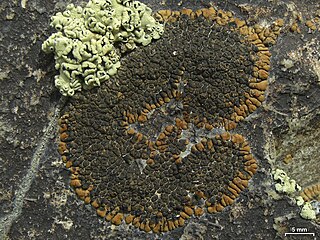
The Parmeliaceae is a large and diverse family of Lecanoromycetes. With over 2700 species in 71 genera, it is the largest family of lichen-forming fungi. The most speciose genera in the family are the well-known groups: Xanthoparmelia, Usnea, Parmotrema, and Hypotrachyna.
Scutula is a genus of lichenicolous fungi in the family Ramalinaceae.

The Lecanoraceae are a family of lichenized fungi in the order Lecanorales. Species of this family have a widespread distribution.

Unguiculariopsis is a genus of lichenicolous fungi in the family Cordieritidaceae. It has 29 species.

Stigmidium is a genus of lichenicolous (lichen-eating) fungi in the family Mycosphaerellaceae. The genus was circumscribed by Italian botanist Vittore Benedetto Antonio Trevisan de Saint-Léon in 1860, with Stigmidium schaereri assigned as the type species.

Sphaerellothecium is a genus of fungi in the family Phyllachoraceae. All of the species in the genus are lichenicolous, meaning they grow parasitically on lichens.

Punctelia is a genus of foliose lichens belonging to the large family Parmeliaceae. The genus, which contains about 50 species, was segregated from genus Parmelia in 1982. Characteristics that define Punctelia include the presence of hook-like to thread-like conidia, simple rhizines, and point-like pseudocyphellae. It is this last feature that is alluded to in the vernacular names speckled shield lichens or speckleback lichens.

Abrothallus is a genus of lichenicolous fungi. It is the only genus in the monotypic family Abrothallaceae, which itself is the sole taxon in the order Abrothallales.

Nesolechia is a genus of parasitic fungi in the family Parmeliaceae. All three species in the genus grow on lichens. Nesolechia probably evolved from a lichen ancestor, as it is closely related to many lichenized species of fungi.
Josef Hafellner is an Austrian mycologist and lichenologist. He was awarded the Acharius Medal in 2016 for his lifetime contributions to lichenology. Before his retirement, he was a professor at the Karl-Franzens-Universität in Graz. Hafellner started developing an interest in lichens while he was a student at this institution, studying under Josef Poelt. He earned a master's degree in 1975 and a PhD in 1978, defending a doctoral thesis about the genus Karschia. In 2003, Hafellner received his habilitation. By this time, he had studied with French lichenologist André Bellemère (1927–2014) at Saint-Cloud, where he learned techniques of transmission electron microscopy and how their application in studying asci could be used in lichen systematics. His 1984 work Studien in Richtung einer natürlicheren Gliederung der Sammelfamilien Lecanoraceae und Lecideaceae has been described as "probably the single most influential publication in lichen systematics in the latter half of the 20th century".

Cordieritidaceae is a family of fungi in the order Cyttariales. Species in this family are saprobes or lichenicolous.

Sclerococcum is a genus of lichenicolous fungi in the family Dactylosporaceae.

Polycoccum is a genus of lichenicolous fungi in the family Polycoccaceae. It has about 60 species.
Raesaenenia is a fungal genus in the large family Parmeliaceae. It is a monotypic genus, containing the single lichenicolous fungus Raesaenenia huuskonenii, which parasitises lichens of genus Bryoria in the Northern Hemisphere.
Phacopsis lethariellae is a species of lichenicolous (lichen-dwelling) fungus in the family Parmeliaceae. It was formally described as a new species in 1995 by Josef Hafellner and Gerhard Rambold. The type specimen was collected by the first author from La Fortaleza at an altitude of 1,180 m (3,870 ft), where it was found growing on the thallus of the lichen Lethariella intricata. It causes formations of galls, which also creates a torsion on the thallus. It has dark brown to black apothecia that are typically 0.3–0.5 mm in diameter, with a convex disc. Its ascospores are ellipsoid to ovoid, measuring 11–13 by 6–7 μm. The fungus, known to occur only in the Canary Islands, is named after the genus of its host.
Henricus (Harrie) Johannes Maria Sipman is a Dutch lichenologist. He specialises in tropical and subtropical lichens, and has authored or co-authored more than 250 scientific publications. He was the curator of the lichen herbarium at the Berlin Botanical Garden and Botanical Museum from 1983 until his retirement in 2010.

Phacopsis vulpina is a species of lichenicolous (lichen-dwelling) fungus in the family Parmeliaceae, and the type species of the genus Phacopsis. It was formally described as a new species in 1852 by French mycologist Edmond Tulasne. The fungus is restricted to the genus Letharia as a host and consequently has a Northern Hemisphere distribution. Externally, it is somewhat similar in appearance to P. lethariellae, but P. vulpina does not have a brown hypothecium.
Phacopsis thallicola is a species of lichenicolous (lichen-dwelling) fungus in the family Parmeliaceae. It was first formally described as a new species in 1852 by Italian botanist Abramo Bartolommeo Massalongo, as Lecidea thallicola. The type specimen, collected from the province of Treviso in Italy, was growing on the foliose lichen Parmelia caperata. Dagmar Triebel and Gerhard Walter Rambold transferred the taxon to the genus Phacopsis in 1988. The known generic hosts of Phacopsis thallicola are all in the Parmeliaceae: Parmotrema, Cetrelia, Flavopunctelia, and Hypotrachyna.












